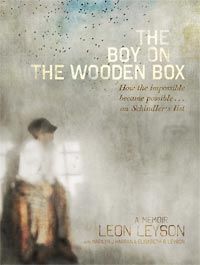Schindler’s List Survivor’s Memoir The Boy on the Wooden Box Published Today

Holocaust survivor Leon Leyson passed away this January, but his story of survival as the youngest boy on Oskar Schindler’s “list” will live on in his new memoir, The Boy on the Wooden Box: How the Impossible Became Possible…on Schindler’s List, which was officially released today.
Leyson gave testimony about his experiences during the Holocaust to USC Shoah Foundation – The Institute for Visual History and Education’s Visual History Archive and maintained a close relationship with the Institute throughout his life.
Leyson was 10 years old and living with his family in Poland when World War II began. He and his family were forced to relocate to the Krakow ghetto and later to Plaszow concentration camp. However, because his father worked at Oskar Schindler’s enamelware factory, Leyson, his parents and surviving sister and brother (two of his brothers had already been killed) were placed on “Schindler’s List” and sent to work in the factory.
Believed to be the youngest boy on the list, 13-year-old Leyson had to stand on a box to reach the factory machinery he was assigned to work on. He quickly became a favorite of Schindler’s, who Leyson said gave him extra rations of food, assigned him to a different part of the factory when he got bored and nicknamed him “Little Leyson.”
In 1949 Leyson emigrated to the United States, where he graduated from Los Angeles City College, California State University, Los Angeles, and Pepperdine University. He taught industrial arts at Huntington Park High School in Los Angeles for 39 years. He reunited briefly with Schindler in Los Angeles in 1965; when Leyson and others greeted Schindler at the airport, Schindler recognized “Little Leyson” immediately.
The Boy on the Wooden Box tells Leyson’s incredible story, which he rarely spoke about until Institute founder Steven Spielberg’s film Schindler’s List premiered in 1993. He then began speaking publicly around the country about his experiences. Leyson is survived by his wife, Elisabeth, and their two children and six grandchildren.